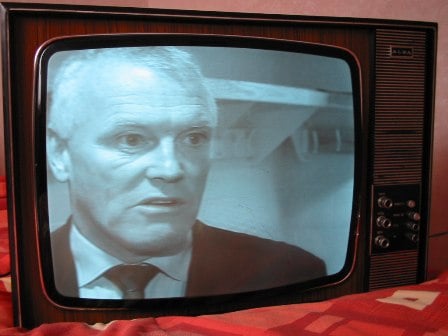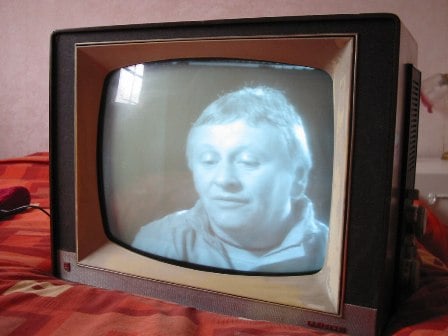With the growth of budget priced colour TVs during the 70s and 80s, black and white sets slowly started to become a thing of the past. However, with a generation or two on and 40+ year olds hankering after a lost childhood, old black and white sets are becoming sought after.
Sets manufactured during the 50’s were designed to work on the VHF 405 line standard which was adopted by the government shortly after the 2nd world war. Up until the mid 50s, sets were shipped, pre tuned to the station which would be locally serving the area in which the set was to be used. In ’57, ITV started transmission, independent of the BBC. With two channels available, sets now had to have multi station tuners.
In ’64, the UHF 625 line TV standard started, now giving the viewer a staggering selection of 3 stations to watch. UHF started life with new BBC2 station. You had to have an additional aerial and not all locations were serviced with UHF. Even in a good area, you could not guarantee good results due to poor sensitivity of the early UHF tuners fitted in sets. It was not until the late ’70s, that 90% of the UK had access to UHF. BBC 1 and ITV soon started parallel transmissions on UHF. Switching between VHF – 405 line operation and UHF – 625 on your new dual standard TV set, was a bit like taking your life in your own hands. The two standards were very different and required the set to process the respective signals in different ways. This was normally achieved by setting a large chunky switch to either VHF or UHF. This switch was connected to a complicated set of cams, levers and multi way switches which altered the way of working of the RF sections, video, sound, frame timebase and line timebase sections of the set. If all when well when you operated the switch, you would get a satisfying clunk and the picture would reappear after a few flashes, lines and crackles from the sound. After the set had been in use for a couple of years and full of dust and smoke deposits for the normal Embassy No. 5s, the switches would stick half way between UHF and VHF, resulting in all kind if strange happenings including the odd puff of smoke and occasional bang. You would now be left with calling out the man in the brown overall who would come out with the standard phrase “sorry love, it’s the picture valve” and stitch you up for £7.10s.6d.
By the early ’70s, sets were single standard UHF only. Colour sets were becoming popular. Rental was the option for the family with a modest income. Early colour sets were not too reliable. They had many valves, lots of heat produced. In ’85, VHF 405 line TV stopped in order that the VHF frequencies on which the service was transmitted, could be made available for mobile phones. Sad day. Although the resolution was not as high as the UHF – 625 standard, the pictures produced on a good set were very good. The standard did last or some 50 years, which I think says a lot. No longer can we hear the comforting 10 Kcs line whistle of the 405 line system and getting three times a night to adjust the vertical and horizontal holds is a thing of the past.
The two sets below were recent restoration projects.


The smaller set, an early Philips dual standard 17″ model came along in a bit of state. It looked like it had been stored in a shed, was rusty, full of dirt, dust and dead residence. A good clean up and slowly applying mains using a variac, produced a dim raster on 405. After both valves were changed in the UHF tuner, Video output valve, RF amplifier valve and Boost diode valve also changed, the set gave a good picture on UHF – 625. The 405-625 switch was to be cleaned considerably. The set was left on for an hour or so, being carefully watched for tell tail signs of something about to go wrong. I was told the set had been stored away for 28 years. Capacitors would not take too kindly to being asked to work after such a long sleep. Sure enough, half way through Delia Smith’s cookery programme, the picture started to narrow, accompanied by a bubbling
The larger of the sets, a Thorn 1500, sporting a big 24″ tube was dead on arrival. Now, anyone who dealt with these sets will tell you that the first thing to check is the 150 ohm section of the mains dropper resistor. This is situated on the top of the PCB. Of course, this section was open circuit. A bridge replacement brought the set to life, but the picture had little contrast. I worked a lot on these sets when I was in my early teens and recalled that this fault was normally due to a capacitor in the video drive section. Sure enough, a few checks and a quick replacement produced a very good picture. I was quite surprised as normally, the larger screen sets seemed to suffer from soft tubes after a few years of use. I then saw that the tube had been replaced with a re-gunned replacement. I was right!
noise. Before I got to the on off switch there was a bang and cloud of smoke. One of the main smoothing capacitors had given up and deposited the contents of its stomach all over the insides of the set. A quick clean up and changing the two main smoothing capacitors produced good results.
Just as a test, I replaced our colour set in the front room with this set. I then told my wife and daughter that I wanted to use this for a night to see if all was well. After two hours, I was asked why the picture was not colour! It’s amassing how the brain makes up for deficiencies. As a result, I sold the colour set and got a black and white licence. That will teach them.


